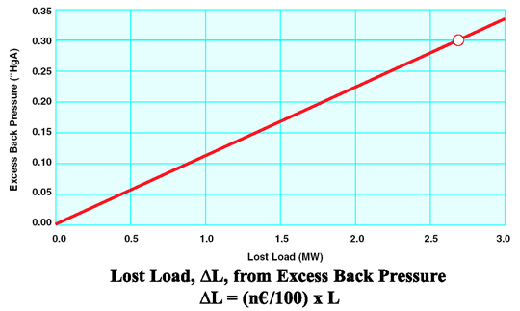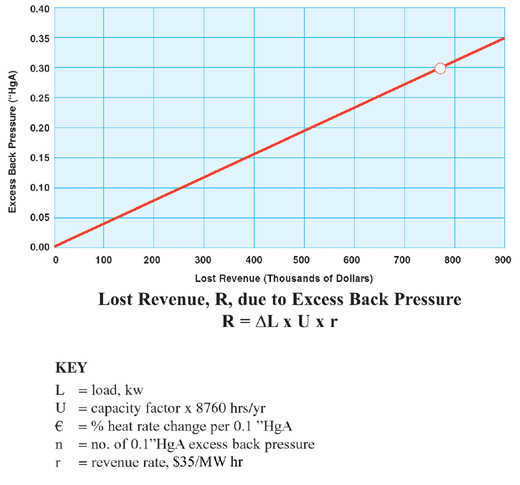

Condenser Problem Analysis
Bionetics has established itself as a leader in solving condenser-related problems and improving condenser performance. Since 1994, Bionetics has been the leading source of new information on condenser dynamics, which has been made possible with the RheoVac instrument. The RheoVac instrument measures the mixture of water vapor and noncondensable gases in the vent line. With this information and other plant measurables, Bionetics developed a Comprehensive Condenser Model and Methods (C2M2) based on physical principles. The C2M2 has been validated under a variety of different operating conditions, and has been used to identify deficiencies in condenser design and problems with condenser operations and maintenance.
If you want your condenser to work better, complete the form on this page and let Bionetics assist you.
You can also learn more about our unique 4-step Condenser Performance Evaluation process and our RheoVac instrumentation for condenser monitoring. For some examples of how we have helped other power plants, read our Case Studies.
COMMON CONDENSER PROBLEMS:
- High Condenser Pressure
- Corrosion
- Dissolved Gases (Oxygen, Carbon Dioxide, Ammonia, etc.)
- Low Cleanliness Factor
- Low Heat Transfer Coefficient
- Air In-Leakage
- Tube Fouling
- Low Pump/Exhaust Capacity
- Other Efficiency/Maintenance/Design/Operations Concerns
High Condenser Pressure
High condenser back pressure is the most obvious plant measurable that results in lost revenue or excess operating costs. Turbine exhaust back pressure is directly related to lost power output to the generator that converts mechanical energy to electrical power. Excess back pressure means reduced efficiency and dollars wasted. Allow Bionetics to better understand your system using the form on this page so we can help in solving your back pressure problem.
How excess back pressure affects the bottom line:
Revenue and profit loss can be significant. As shown in the charts below, even a small excess back pressure will have a dramatic impact. These results are based on a PEPSE analysis of a 525MW generating unit which shows that each 0.1”HgA rise in back pressure results in an increase of 0.17% in heat rate. In summary, a 0.3” HgA of excess back pressure, on a base loaded plant condenser, correlates to a loss of 2.68MW of power and nearly $770,000/year lost revenue.


Corrosion/Dissolved Gases (Oxygen, Carbon Dioxide, Ammonia, etc.)
Dissolved Oxygen (DO) and other gases are a major cause of corrosion in the steam cycle. Corrosion leads to forced outages and increased maintenance costs. A common misconception is that high DO is concurrent with high air in-leak; this is not always the case. High DO and condensate CO2 concurrent with low air in-leakage is an indication that the condenser configuration may be inadequate. Allow Bionetics to better understand your system using the form on this page so we can help in solving your problem with corrosion or dissolved gases.
Bionetics’ condenser services group reduces DO by >70% at Entergy’s Little Gypsy. Read More (PDF)
Low Cleanliness Factor/Low Heat Transfer Coefficient
Cleanliness Factor (CF) is calculated by measuring the ratio of the actual heat transfer coefficient as a percent of the associated HEI specified design heat transfer coefficient. Low CF measurement could be the result of one or many problems occurring in a plant, and indicates a lower than desired power generation efficiency; thus, dollars wasted. Allow Bionetics to help you better understand your system using the form on this page so we can help in solving your problem of having a low cleanliness factor or low heat transfer coefficient.
Air In-Leakage
Multiple pathways for air to leak into the steam path are inherent to the sub-atmospheric side of steam turbine power plants. Air in the steam path, along with deficiencies in condenser configuration, are major causes for a number of plant related problems such as excess back pressure, dissolved oxygen, corrosion, and low cleanliness factor. Quantifying this air in-leakage is essential for maintaining plant operations. RheoVac instruments are the solution to measuring air in-leakage. The RheoVac instrument succeeds where all other air flow monitors fail, because it is the only instrument that is based on the direct measurement of vent line gas parameters to accurately calculate air in-leakage. Additionally, RheoVac instruments provide plant operators with other essential data to respond to common plant maintenance issues, such as monitoring exhaust pump capacity, real-time verification of leak repairs, vacuum quality, and tube fouling. Allow Bionetics to better understand your system using the form on this page so we can help in solving your air in-leakage problem.
Tube Fouling
Tube fouling occurs when biologic growth or material deposits obstruct the cooling circulating water flow through condenser tubes. Tube fouling manifests itself in many plant measurables. Without direct measurement of individual tube flow rates, however, other problems such as poor condenser configuration can lead to false presumption of tube fouling. Bionetics offers instrumentation for monitoring individual Tube Fouling. Use the form on this page to let Bionetics help with your tube fouling problem.
Low Pump/Exhaust Capacity
Exhaust pump capacity must be maintained to ensure proper air removal from the condenser. Insufficient air removal can lead to increased back pressure, high dissolved oxygen, and low cleanliness factor. RheoVac instruments provide an accurate and real time measurement of pump capacity. Complete the form on this page to help you better understand and solve your low pump/exhaust capacity problem.
Other Efficiency/Maintenance/Design Concerns
For decades, Bionetics has solved flow and engineering problems for many customers. Bionetics’ success is based on a fundamental understanding of physics and engineering backed by a team of knowledgeable and experienced science and engineering professionals. Take advantage of Bionetics’ experience in resolving power plant condenser-related issues by contacting us today using the form on this page.
